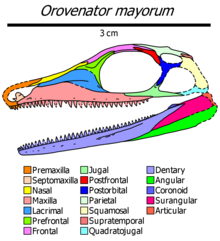Neodiapsida
| Neodiapsids | |
|---|---|

| |
| Skull of Orovenator, the earliest known neodiapsid | |

| |
| Skeleton of Megalancosaurus, a drepanosaur | |
| Scientific classification | |
| Domain: | Eukaryota |
| Kingdom: | Animalia |
| Phylum: | Chordata |
| Class: | Reptilia |
| Clade: | Diapsida |
| Clade: | Neodiapsida Benton , 1985
|
| Subgroups and genera | |
| |
Neodiapsida is a clade, or major branch, of the reptilian family tree, typically defined as including all diapsids apart from some early primitive types known as the araeoscelidians. Modern reptiles and birds belong to the neodiapsid subclade Sauria.
The oldest known neodiapsids are Orovenator and Maiothisavros from the Early Permian of North America, around 290 million years old.[1][2]
Basal-non saurian neodiaspids were ancestrally lizard-like, but basal non-saurian neodiapsids include aquatic/amphibious taxa (
Classification
The clade Neodiapsida was given a
| Diapsida |
| |||||||||||||||||||||||||||||||||||||||||||||||||||||||||
This second cladogram is based on the 2017 study by Pritchard and Nesbitt.[15]
| Neodiapsida |
| |||||||||||||||||||||||||||||||||
The following cladogram was found by Simões et al. (2022): [16]
| Neoreptilia |
| ||||||||||||||||||||||||||||||||||||||||||||||||||||||||||||||||||||||||||||||
References
- Callaway, J.M. (1997), Ichthyosauria: Introduction, in JM Callaway & EL Nicholls (eds.), Ancient Marine Reptiles. Academic Press, pp. 3–16.
- Laurin, Michel and Gauthier, Jacques A. (2000) Autapomorphies of Diapsid Clades
External links
- Eureptilia: Neodiapsida
- Neodiapsida cladogram



